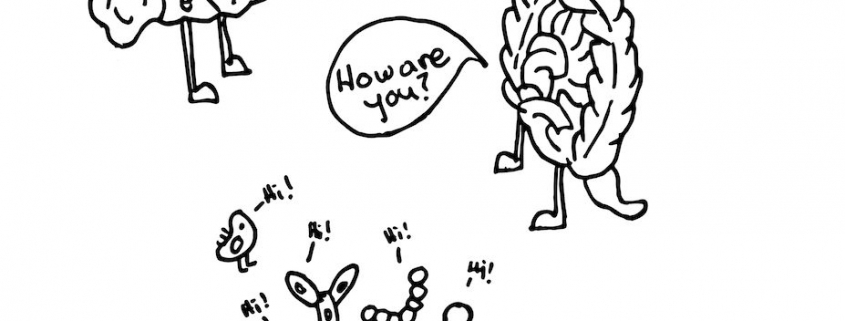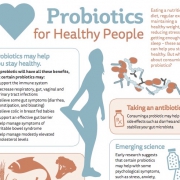Bugs on the Brain: the Microbiota-Gut-Brain Axis
September 2017. By Eamonn M. M. Quigley, Chief Division of Gastroenterology and Hepatology, Houston Methodist Hospital and Professor of Medicine, Weill Cornell Medical College, Houston, Texas, USA.
We can all remember those instances of diarrhea (or at least frequent bowel movements) and “butterflies” that we suffered before a critical test, interview or presentation. These are examples of stress originating from the brain influencing gut function. Extensive research over the past several decades has revealed that this is a two-way street – the gut constantly signals to the brain, too. This bidirectional channel of communication between the “big brain” in the cranium and the “little brain” (i.e. the enteric nervous system) in the gut came to be referred to as the gut-brain axis. This link relies on neurons of the sympathetic and parasympathetic nervous systems, as well as circulating hormones and other neuromodulatory molecules.
We now understand that mental symptoms of stress, anxiety or depression have a clinical impact on the gut. These include situations where the brain, the gut and their channel of communication, the autonomic nervous system, are affected by the same pathologic process. Parkinson’s disease is a prime example. Indeed, a hypothesis has evolved to suggest that Parkinson’s disease actually originates in the gut and ascends to the brain. Other scenarios include those instances where neurologic symptoms are a consequence of a primarily gastrointestinal pathology. This occurs in malabsorption syndromes when nutrients such as folic acid and B12, which are critical to brain function, become deficient. Finally, and most commonly, are those situations such as irritable bowel syndrome (IBS) where it is widely believed that symptoms result from dysfunction or disturbance somewhere along the gut-brain axis. In some individuals the problem may lie primarily in the gut; in others the main issues may be a distorted representation of gut stimuli in the brain.
Recently the concept of the gut-brain axis has been extended to include the microbiota (the microbiota-gut-brain axis) and tantalizing evidence suggests that bacteria resident in the gut could have an impact on the “big brain”. Indeed, some researchers have raced ahead to suggest that assessing alterations in the microbiome could assist in the diagnosis of a host of neurological disorders and that therapies targeted at the microbiome could play a central role in disorders as diverse as Parkinson’s disease, Alzheimer’s disease, amyotrophic lateral sclerosis, autism, stroke, depression and drug addiction.
We should remember that the microbiota-gut-brain axis is far from a novel concept as it was clearly described over 60 years ago with research on hepatic coma. Metabolic products of gut bacteria lead to this much feared complication of advanced liver disease and an intervention targeted at the microbiome, namely, the administration of antibiotics, was shown to be dramatically effective. In these pioneering studies the role of bacterial overgrowth in the small bowel by coliforms and other bacteria, which are normally confined to the colon, was found to be important. Subsequently, these same bacteria and the inflammatory response that they evoke have been incriminated in the pathophysiology of another common consequence of chronic liver disease, portal hypertension, as well as in other complications such as spontaneous bacterial peritonitis, systemic sepsis and hemostatic failure. Indeed, there are several manifestations of this tripartite resonance between microbiota, the liver and the central nervous system. Gut health factors such as small bowel bacterial overgrowth, an abnormal microbiota, impaired gut barrier function, a pro-inflammatory state and the appearance in the systemic circulation of neuro-active molecules generated by bacterial metabolism are all postulated to play important roles in the actual pathogenesis of a number of common liver diseases. So what is new?
From the basic science laboratories and a variety of animal models a pretty coherent message has emerged. Firstly, the microbiome can influence brain development, structure and function and lead to changes in cognition and behavior. Secondly, the manipulation of the microbiome – for example, with probiotics – can ameliorate certain brain disorders and reverse impaired function. Thirdly, the inoculation of microbiota samples from individuals with a number of neuropsychiatric disorders into animal models can recapitulate features of the human disease. So far so good.
As always, extrapolation from animal studies to humans is fraught with difficulties: differences between animal and human brains and microbiota, the limitations of animal models of psychiatric and functional bowel disorders, and, above all, the challenges of studying brain function in humans. The good news is that these challenges are being addressed. Researchers are utilizing various technologies that provide dynamic images of brain function in various parts of the brain in response to a variety of situations, stimuli and exposures. These are now beginning to provide evidence that our microbiota can influence brain function and that the gut microbiota might, indeed, be a therapeutic target for patients with disorders such as depression, Parkinson’s disease and autism. Data are preliminary and certainly not at a stage where we can offer diagnostic testing based on a fecal sample or recommend antibiotics, prebiotics, probiotics or fecal microbiota transplantation for a given neuropsychiatric disease or disorder. But watch this space!















